|
The Qal Perfect Conjugation - Stative Verbs
There are two functional types of verb that appear in the Qal stem:
- The Fientive - verbs that describe an action (i.e., "he walked"). This is the functional sense of the Qal active stem.
- The Stative - verbs that express a state of being (i.e., "he was young").
A stative verb indicates a state of being, condition, or quality other than action (and therefore most stative verbs are intransitive). The vocabulary for this section lists some common stative verbs found in the Tanakh.
Hebrew Grammars sometimes make a shtush about stative verbs, but there are essentially only a couple of points you need to keep in mind to deal with them:
- The 3ms form is odd and uses a different stem vowel (either Tsere or Cholem), but otherwise they are conjugated just like the standard Qal perfect (one implication of this is that the lexicon will list the spelling of the verb using a different stem vowel than the patach, which you would expect for the Qal perfect).
- Stative verbs are translated as a participle (verbal adjective) with the verb "to be."
The Tsere Stative
The Tsere Stative is marked with a Tsere for the stem vowel in the Qal Perfect:
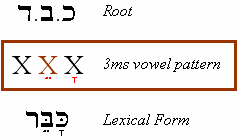
The Qal perfect paradigm for kaved, "to be heavy" is as follows:
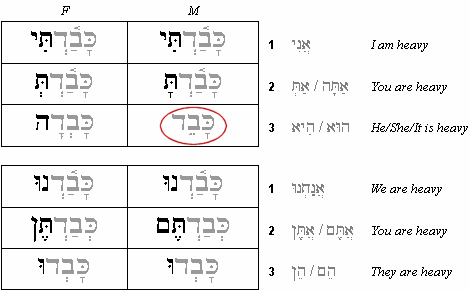
Notice that the 3ms form (i.e., the lexical form) is the only change in the conjugation that you have already studied in Unit 8.2 for the Qal Perfect of strong verbs. The verb zaken is conjugated in the same way. Be aware that the qal perfect 3ms and the masculine singular adjective forms are identical (as are the qal perfect 3fs and the feminine singular adjective forms).
Example (Genesis 48:10a):

The Cholem Stative
The Cholem Stative is marked with a Cholem for the stem vowel in the Qal Perfect:
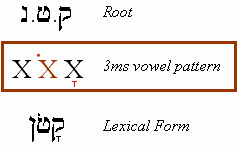
The Qal perfect paradigm for katon, "to be small" is as follows:
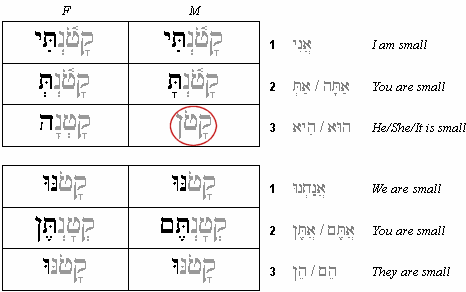
Notice that the 3ms form (i.e., the lexical form) is the uses the Cholem stem vowel (instead of Patach) and that this follows throughout the conjugation (the Qamets is Chatuph in the 2mp and 2fp forms) -- except in the 3fs and 3cp forms, where it drops out entirely. The verb yakhol is conjugated in the same way. Be aware that the qal perfect 3ms and the masculine singular adjective forms are identical (as are the qal perfect 3fs and the feminine singular adjective forms).
Example (Genesis 32:10a):

The Patach Stative
The Patach Stative is marked with a Patach for the stem vowel in the Qal Perfect:
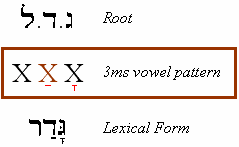
The Qal perfect paradigm for gadal, "to be great" is as follows:
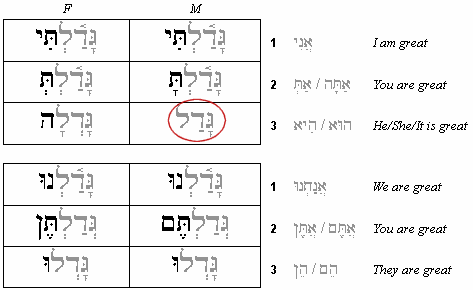
Note that this paradigm looks identical to the standard Qal Perfect paradigm for strong verbs. The difference is in the meaning of the verb. Instead of an "action" verb of the normal Qal Active, the Qal Stative represents a state of being or condition.
Example (Psalm 104:1a):

Section Exercises
- Memorize the vocabulary at the top of the page.
- Memorize the Qal stative paradigms for kaved and katon.
- Conjugate and recite each of the verbs listed in the vocabulary at the top of the page.
- Lookup some additional stative verbs in your Hebrew dictionary and make flash cards for them. Write their standard definition and list their Qal perfect forms.
- For stative verbs, remember that the qal perfect 3ms and the masculine singular adjective forms are identical (as are the qal perfect 3fs and the feminine singular adjective forms).
|












